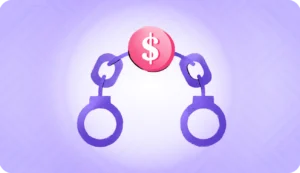The costs of embezzlement are high. In a 1996 study performed by the Association of Certified Fraud Examiners, they discovered that embezzlement schemes cost businesses over $400 billion per year, and contributed to over 50% of business failures.
Embezzlement occurs when internal controls are weak, financial transactions are not properly tracked, financial records are not checked, and periodic audits are ignored. When embezzlement occurs, it can also mark the company as a potential target for money laundering, making it vital to ensure that no Ponzi scheme is hatched.
Today, embezzlement continues to be a major problem, and business owners need to watch out for the signs. The following embezzlement examples should serve as a starting point for any business to avoid this form of white-collar crime.
What is Embezzlement?
Embezzlement is a type of white-collar crime that involves the intentional misappropriation of company funds or assets by someone in a position of trust. It can occur in various settings, including businesses, non-profit organizations, and government agencies. Embezzlement can be committed by employees, executives, or even business owners, and can result in significant financial losses and damage to reputation.
Common Embezzlement Examples
There are many different ways in which trusted employees can siphon money from the company funds. Some methods are common, others less so. In this list, we cover the most common types of embezzlement. This list of embezzlement examples is not exhaustive, but covers most forms of financial fraud that is connected to employee embezzlement.
Misappropriation of Assets
Embezzlement schemes are a broad term, and as such cover a number of actions. Put simply, misappropriation of assets refers to any form of unauthorized use of funds or property, even if the person in question has access to the assets involved.
The more fungible the company assets are, the easier embezzlement becomes. For example, theft of petty cash or checks is quite common, as is the unauthorized use of company credit cards for personal gain. If employees inflate expense reports or bill the company for personal purchases, that is also considered misappropriation.
Fraudulent Disbursements
While misappropriation can be done by one person on impulse, fraudulent disbursement, often part of larger embezzlement schemes, requires planning and support. Employees and executives who use fraudulent disbursement often do so by creating fake vendors or employees, allowing them to submit invoices and siphon company funds.
If the embezzler is particularly skilled, they can commit different kinds of check fraud as well. By forging signatures on checks or intercepting and endorsing checks, they can take advantage of weak internal controls to transfer money to any bank account that they wish. The best way to catch this type of embezzlement is to track financial transactions and maintain good business records.
Skimming
Usually performed over a long period of time, embezzlement schemes and skimming involve the theft of cash receipts before they are recorded, for example, from a cash register. This makes skimming much easier to hide in sectors where large numbers of cash payments take place, like retail. When skimming, employees may take the cash from sales, or they may receive checks and convert them for personal profit. To hide the thefts, they may use techniques like issuing fake refunds or manipulating cash balances to keep them within accounting tolerances.
Larceny After Receipt
This form of embezzlement is more common on smaller scales, and relatively hard to hide. Larceny after receipt is a form of embezzlement where individuals unlawfully take something that they had been entrusted with, often as part of various embezzlement schemes.
For an incident to qualify as larceny after receipt, the individual needs to have received the property legally, for example, an employee receiving tools needed to do their job. Then the perpetrator needs to convert the property to their own use without authorization, like taking the property home or using it for personal errands. Larceny after receipt usually involves acts like stealing cash after it’s recorded, or stealing company property like inventory or equipment for personal use or resale.
Payroll Schemes Involving Company Funds
A form of misappropriation, payroll and embezzlement schemes are used by employees or external agents to siphon company money from a company’s payroll system. There are several common types of payroll fraud, with the most common being ghost employees. In this scheme, the embezzler adds fake employee profiles to the payroll records and transfers the fraudulent earnings to their personal account or a separate bank account. These fake employees can also be used for other scams.
Business owners can also manipulate the account books, making them show that some employees are being overpaid while pocketing the difference. Improper payroll management can also result in terminated employees continuing to receive payment, which is also considered a form of fraud. The best way to catch payroll fraud is to conduct periodic audits of the payroll records or employee records.
Corruption
Embezzlement schemes are quite possibly the most common example of corruption, which can be found everywhere. While corruption doesn’t always meet the strictest definition of embezzlement, there is enough overlap to justify including it here. Accepting kickbacks or bribes to manipulate bids or contracts can enable embezzlement, especially in combination with payroll or disbursement fraud.
In other cases, it can also overlap with vendor fraud, where the employee creates fake vendor accounts to steal payments. This is an issue for large companies, where thorough background checks are harder to do due to the number of employees, and suspicious activities go under the radar
Siphoning
Where skimming involves taking small amounts from multiple transactions, siphoning involves embezzlement schemes where all the money paid during a transaction is taken and simply not reported. Alternatively, employees can overcharge customers and pocket the difference, or even transfer small amounts of money to their personal accounts while avoiding detection. These types of embezzlement are relatively small in scale but can lead to long-term losses.
Check Kiting
If a criminal is embezzling, they need a way to hide it through embezzlement schemes. If, for example, money needs to be withdrawn from an account that the embezzler has drained, they use a method called Check Kiting to hide the shortfall.
This scheme exploits the time it takes for checks to clear between different banks. An employee writes checks from one account that lacks sufficient funds, covering them with checks from another account, creating a false sense of available funds.
The embezzler can continue this cycle, writing checks between multiple accounts to make sure that the accounting records show no suspicious activities. This creates a web of transactions, making it much harder to detect embezzlement. Proper analysis of business records and accounts payable may help.
Lapping
Similar in method to Ponzi schemes, lapping is a form of embezzlement often seen in embezzlement schemes. In lapping, an employee pockets the cash from one transaction and uses money from subsequent transactions to cover the theft from the first one. As long as new customers keep coming in, the employee can continue hiding the theft. However, any slowdown will leave the employee unable to cover the shortfall, easily exposing the theft. Proper accounting systems will also render this scheme infeasible.
Kickbacks
While kickbacks do not fall under the umbrella of embezzlement, they are often part of larger embezzlement schemes. Kickbacks, a form of white collar crime, are sums of money given to a corrupt individual by a vendor in exchange for preferential treatment. When the vendor is then awarded contracts or business, the individual in question often inflates costs to cover the kickback or siphon more money away.
Overtime Fraud
Overtime Fraud is a type of embezzlement where employees claim payment for more hours than they actually worked. Irregular work hours and limited oversight contribute heavily to overtime fraud, and the resulting inflation in pay rate is a strong incentive.
There are several ways in which overtime fraud is done, with the most common method being falsifying overtime records as part of embezzlement schemes. Employees may also collude with others to have someone else punch them in or out, or may create fake overtime requests to inflate the registered company time. The best way to prevent embezzlement in this regard is to maintain proper biometric systems to punch in and out.
Physical Asset Misappropriation
From tools to machines to vehicles, physical assets are important to the proper function of any business that depends on them. Physical asset misappropriation occurs when employees steal physical assets like equipment or inventory through embezzlement schemes. This is a fairly common form of embezzlement, and is more closely associated with larceny. Theft of office supplies usually falls under this category, as people take them and start considering them as personal property.
Invoice Fraud with Fake Vendor Accounts
Increasingly prevalent in today’s digital environment, invoice fraud and embezzlement schemes involve creating fake invoices for services or products that were never provided and directing bank deposits to personal accounts.
There are many different types of invoice fraud. Scammers can inflate legitimate invoices, taking advantage of busy departments to ignore discrepancies. They can intercept and change payment details on invoices to redirect funds to their own accounts. They can even submit duplicate invoices to take advantage of weak internal controls.
Credit Card Fraud
Unauthorized use of a company credit card for personal expenses is considered credit card fraud, especially when it is part of embezzlement schemes disguised as legitimate business expenses. However, these cards and their use are tracked, so it is relatively easy to catch.
Misuse of Company Resources for Personal Gain
Embezzlement schemes fall under the broader umbrella of misappropriation, referring to the misuse of company resources for personal gain, such as using company vehicles for personal errands or taking company supplies for personal use. It can tie into physical asset misappropriation as well.
Financial Statement Fraud
Financial statement fraud is a type of embezzlement that involves manipulating financial records to conceal the theft of company funds or assets. This can include falsifying financial statements, hiding transactions, or creating fake vendor accounts. Financial statement fraud can be difficult to detect, but can have serious consequences for businesses and individuals.
Popular Embezzlement Cases in the Real World
Bernard Madoff Ponzi Scheme
Madoff orchestrated one of the largest embezzlement schemes and Ponzi schemes in history, defrauding investors of approximately $65 billion. He promised consistently high returns and used funds from new investors to pay earlier investors, ultimately leading to his arrest in 2008.
Fry’s Electronics
Ausaf Umar Siddiqui, a vice president at Fry’s Electronics, orchestrated embezzlement schemes and embezzled over $65 million through vendor kickbacks. He was sentenced to six years in prison for his actions, which were driven by a gambling addiction.
Enron
The Enron scandal involved executives engaging in embezzlement schemes and accounting fraud to hide the company’s financial losses. This led to the company’s bankruptcy in 2001 and significant financial losses for investors and employees.
WorldCom
WorldCom executives inflated the company’s assets by $11 billion through embezzlement schemes and fraudulent accounting practices. The scandal led to the company’s bankruptcy in 2002 and resulted in significant reforms in corporate governance.
The City of Dixon
The former comptroller of Dixon, Illinois, orchestrated embezzlement schemes, embezzling $53 million over several years by creating fake accounts and diverting funds for personal use. She was sentenced to nearly 20 years in prison.
The Catholic Church Scandal
Embezzlement schemes have been at the center of numerous cases involving church officials embezzling funds intended for charitable purposes. One notable case involved a priest who stole over $1 million from a church in California to fund a lavish lifestyle.
Preventing Embezzlement
Preventing embezzlement requires a combination of internal controls, regular audits, and a culture of transparency and accountability. Here are some ways to prevent embezzlement:
Implementing Internal Controls
Implementing internal controls is a crucial step in preventing embezzlement. This can include:
- Separating duties and responsibilities to prevent one person from having too much control over financial transactions
- Conducting regular audits and reviews of financial records
- Implementing a system of checks and balances to detect and prevent fraudulent activity
- Providing training and education to employees on financial management and ethics
- Establishing a clear policy on personal expenses and company assets
By implementing these internal controls, businesses can reduce the risk of embezzlement and protect their financial assets.
Final Thoughts
If you suspect embezzlement or notice any of the warning signs, surprise audits are a good way to start tackling the problem. You can also cultivate a culture of anonymous reporting, and make sure that your whistleblower policies are strong.
Given the amount of damage these fraudulent activities can cause, it is best to heed the warning signs and enact preventive measures. Proper financial management also helps. Laws against embezzlement are strong, and filing criminal charges is a good way to reduce the likelihood of such actions in the future.
One of the worst aspects of suffering embezzlement is the knowledge that a trusted member of your team has been stealing from the company. Combine that loss of trust with the financial and reputational loss, and it becomes obvious why embezzlement leads to so many companies shutting down.
Embezzlement is a problem that takes many forms. From cashiers to CEOs, the risk always exists that one of them may decide to start taking money for themselves. On top of that, detecting this kind of fraud becomes harder as financial systems grow more complex.
Given these issues, vigilance and prevention are the best ways to prevent embezzlement. A proper fraud prevention solution like HyperVerge can go a long way towards protecting you from this problem.
FAQs
1. What is the most common type of embezzlement?
The most common type of embezzlement is misappropriation of company funds.
2. Can embezzlement be unintentional?
No, embezzlement cannot be unintentional.
3. What are the consequences of embezzlement?
Consequences of embezzlement include financial losses and loss of reputation.
4. How can businesses detect embezzlement?
Businesses can employ strong internal controls, perform regular audits, perform background checks, and limit access to funds. However, the best option is to install a fraud prevention solution like HyperVerge.





